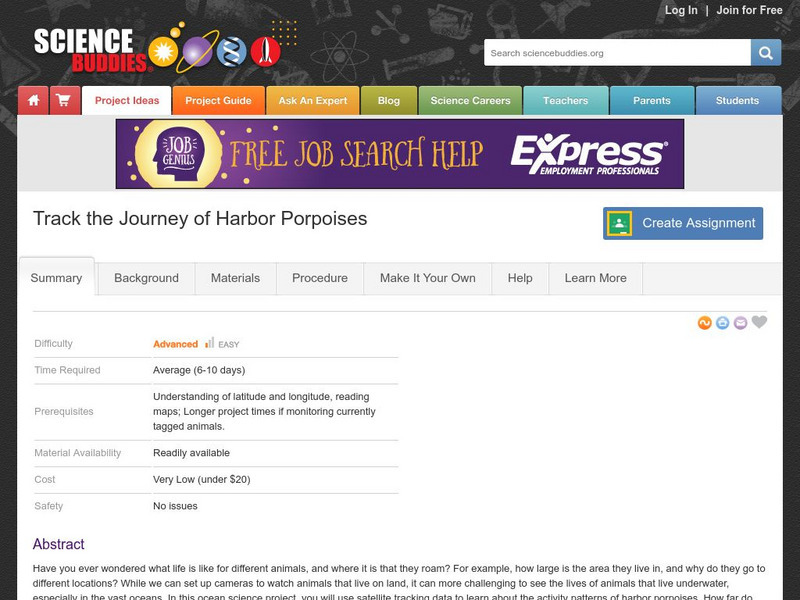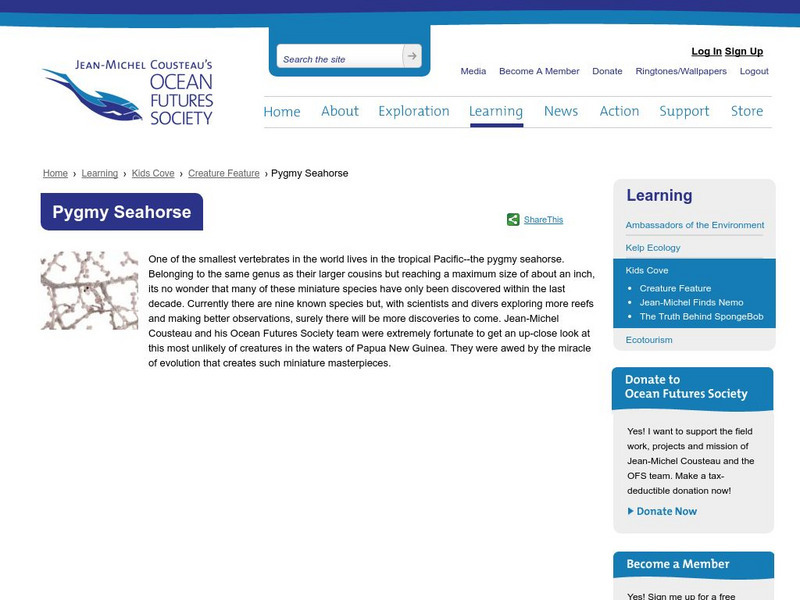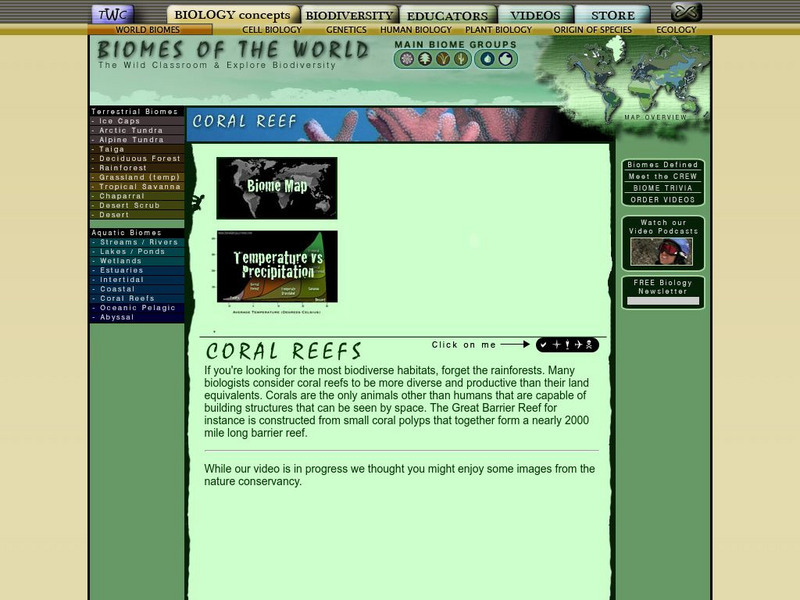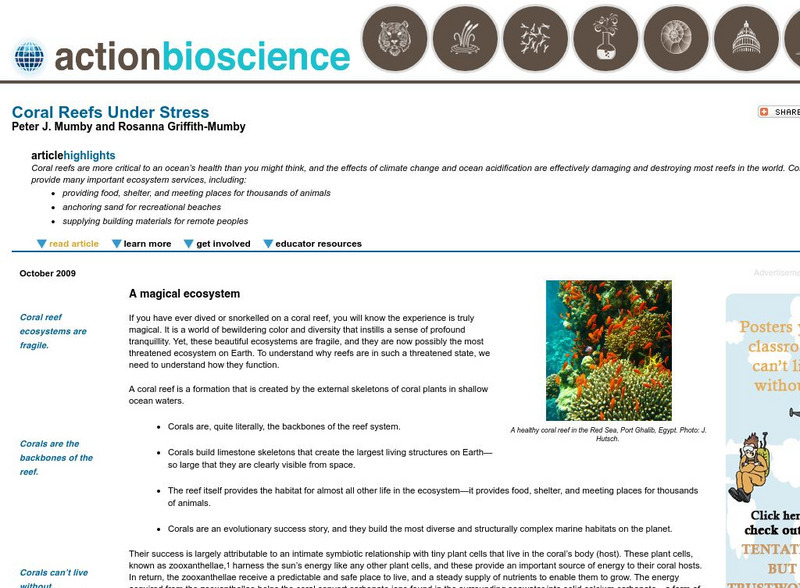Science Buddies
Science Buddies: Harbor Porpoise Movement
In this project you can use archived satellite tracking data to learn about activity patterns of harbor porpoises. How far do they travel? Can you find patterns in the routes individual animals take? Can you correlate their route with...
Science Buddies
Science Buddies: Timing the Tides
Have you ever been to a tide pool during low tide? Some intertidal animals in the low tide zone are left in a tiny pool of water when the tides go out. Other intertidal animals that live in high tide zones may be left to dry out during...
Read Works
Read Works: Ocean Animal Discovery
[Free Registration/Login Required] An informational text about the discovery of ocean animals. A question sheet is available to help students build skills in reading comprehension.
Other
Ocean Futures: Kids: Creature Feature: Pygmy Seahorse
Learn about this truly unique animal and where it can be found, in Papua New Guinea. Includes video.
National Geographic
National Geographic: Adapting Under Pressure
Students learn about James Cameron's Challenger Deep dive and about the marine animals that live in different layers of the ocean. They then study the characteristics of the hadalpelagic zone at the bottom of the ocean, and imagine and...
The Wild Classroom
The Wild Classroom: Biomes of the World: The Deep Sea Biome
Learn all about the abyssal ocean ecosystem. Find out about plants, animals, adaptations, and conservation efforts.
The Wild Classroom
The Wild Classroom: Biomes of the World: Intertidal Zone
Learn about the intertidal ecosystem. Find out about plants, animals, adaptations, and conservation efforts.
The Association of the British Pharmaceutical Industry
Abpi: Human and Animal Habitats
An interactive learning game where students answer whether or not certain environments would be suitable for different animals. Printable worksheets are available for review at the end of the activity.
Enchanted Learning
Enchanted Learning: Biomes
Discover the hidden treasures in the different habitats on the earth! The earth is filled with many biomes. Examples of different biomes are listed and include hyperlinks to additional information such as the animals found there.
Globio
Glossopedia: Environments
This article defines "environment" as a collection of animals and plants in a specific landscape and climate. The concept of differing types of environments is introduced. The impact of humans on environments and all environments'...
The Wild Classroom
The Wild Classroom: Biomes of the World: Coral Reef Biome
Learn about the coral reef ecosystem. Find out about plants, animals, adaptations, and conservation efforts.
American Institute of Biological Sciences
Action Bioscience: Coral Reefs Under Stress
Coral reefs, home to many vibrant plants and animals, are suffering from the affects of climate change and the increase of acid in ocean waters. Delve into the benefits and concerns of these beautiful ecosystems.
Globio
Glossopedia: Seals
Seals are mammals that live parts of their lives on land and other parts entirely in the water. They breed and care for their babies on land, but spend most of their lives in the ocean. This article provides an in-depth look at these...
Ducksters
Ducksters: Animals for Kids: Clownfish
Kids learn about the Clownfish, orange and white famous coral reef fish from Finding Nemo.
Ducksters
Ducksters: Animals for Kids: Gold Poison Dart Frogs
Kids learn about the Gold Poison Dart Frog, poisonous amphibians from South America.
Ducksters
Ducksters: Animals for Kids: Lionfish
Kids learn about the Lionfish, beautiful but poisonous reef fish with stripes.
Ducksters
Ducksters: Sea Turtles for Kids: Learn About These Reptiles of the Ocean
Kids learn to identify sea turtles including different species loggerhead and leatherneck. These reptiles are endangered.
Curated OER
Ocean
Discover more about the underocean environment at this site that surveys animals, environmental factors such as light and temperature, currents, animals, plants, and the like.
HotChalk
Hot Chalk: Lesson Plans Page: Ocean Unit Introduction
This lesson will introduce young students to oceans by looking at the animals, plants and water temperatures for different oceans.
World Wildlife Fund for Nature
Wwf: Our Earth: Ecoregions: Habitats: Oceans
An introduction and overview of the ocean habitat, the largest habitat on Earth. Includes links to information about three animals that live in this habitat.
Science Struck
Science Struck: The Differences Between Benthic and Pelagic Zones
Learn the characteristics of these two oceanic zones and of the plants and animals that live in them.
Wikimedia
Wikipedia: Bathyal Zone
Learn where this ocean zone is located, average temperature and the unique traits of the animals that reside there.
Other
Aquarium Kaiukan: Creatures and Anecdotes (Japanese)
The Japanese-language homepage of the Osaka Kaiukan Aquarium, one of the largest in the world. It introduces visitors to the creatures that inhabit zones of the Pacific, from the Aleutian Islands in the north to Antarctica in the south....
Missouri Botanical Garden
Missouri Botanical Garden: Temperate Oceans Light Zones
Discover the three zones in the ocean which are determined by the amount of light received from the sun. Pictures illustrate the three zones and there is a listing of the animals that live in each zone.
Other popular searches
- Ocean Ecosystems Animals
- Oceanic Trenches and Animals
- Grassland Animals Ocean
- Ocean Plants and Animals
- Oceans Animals
- Oceanic Animals Adaptations




















